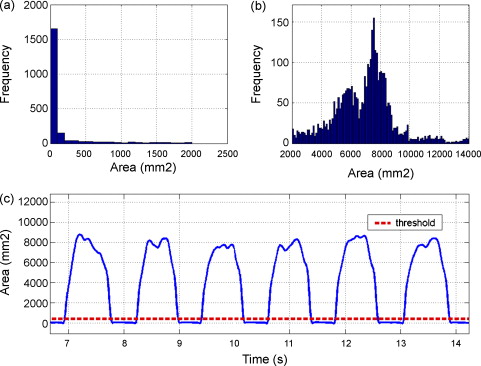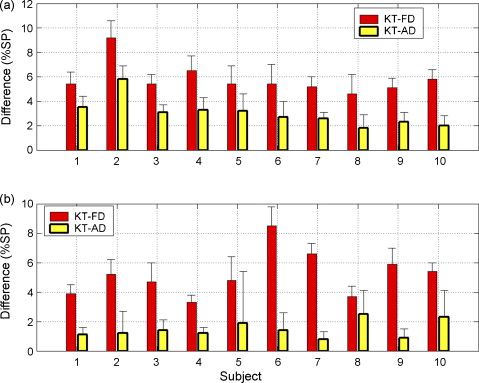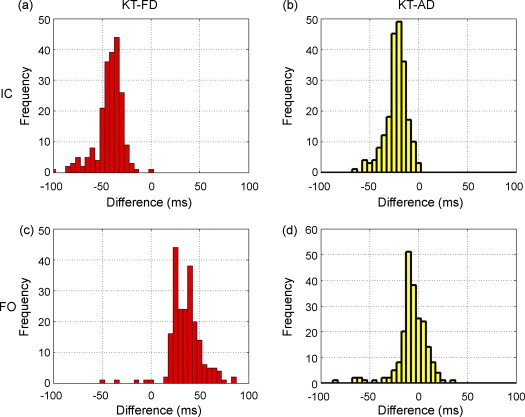Detection of gait events using an F-Scan in-shoe pressure measurement system
比较了force-based detection (FD,软件自带)和area-based method (AD) ;kinetic detection(KT,使用force platforms的数据)作为validation
对F-Scan® system准确性的讨论
Several studies have evaluated the accuracy and reliability of force and pressure measurements using the F-Scan® system and reached different conclusions. While some authors concluded that F-Scan demonstrated good to excellent reliability in measuring plantar pressures [11], others concluded that the system was not entirely suitable for accurate and repeatable absolute pressure measurements [12], [13], [14] or that the system could be used only in a sample large enough as to allow the detection of the real effect of the treatment [15]. Other studies suggested that errors could be greatly minimized by adequate preparation and use of the system [16], [17], [18], [19], [20]. These and similar studies show that the system could provide valuable information but care should be taken when measuring absolute values of force or pressure.
[16], [17]建议subject先走10min保证温度+适应,所以可以先穿上鞋再贴IMU
Methods & Results
KT 10N threshold
FD
$\text{force threshold}= \text{minimum}+(\text{maximum}-\text{minimum})\times \frac{10}{100}$
AD
$\text {area threshold}=\mathrm{ALS} \mathrm{w}+(\mathrm{ALSt}-\mathrm{ALSw}) \times \frac{5}{100}$
统计load area,出现频率最高的小面积($< 2000 \text{mm}^2$)就是$\text{area loaded during swing (ALSw)}$,($>2000 \text{mm}^2$) 的up to the maximum area (b) was used to find the $\text{area loaded during stance (ALSt)}$

5 set by visually inspecting
statistical analysis
A 2 (insoles sets: 1 and 2) × 2 (time differences with respect to the gold standard for methods FD and AD) mixed design analysis of variance (ANOVA) was used for the analysis, with time differences serving as the within subjects factor.
The results of the statistical test for IC showed that there was a significant effect for the methods factor, F (1, 8) = 348.5, p < 0.01. The effect of the insoles sets was not significant, F (1, 8) = 0.35, p > 0.05, and the interaction of insoles sets and methods was also not significant, F (1, 8) = 5.1, p > 0.05.
For FO, the statistical test also showed a significant effect for the detection methods, F (1, 8) = 600.2, p < 0.01. The effect of the insoles sets was not significant, F (1, 8) = 0.77, p > 0.05, and the interaction of insoles sets and methods was also not significant, F (1, 8) = 11.1, p > 0.05.


KT的阈值选取
直接用阈值最好是使用测力板"gold standards",但也可以用insole pressure sensor1
IPSs are often considered as an alternative to force plates in validation studies due to several advantages including cost factor, wearability, and unconstrained movement that allows natural gait in both indoor and outdoor environments.
Despite these advantages, there are some constraints to consider. IPSs are typically placed inside the shoe and are thus subject to pressure between it and the foot, which can lead to non-zero pressure readings even when the foot is in swing phase. Although IPSs are comparable to force plates when it comes to estimation of temporal features, using them for real-time ground reaction force estimation is not recommended since it takes a considerably longer time to reach the set value compared to a force plate.
- Different thresholds algorithms proposed: a fixed threshold for both events of zero [24], 2.5 N [25] and 10 N [8], [9], [26], a combination of 10 N for IC and 5 N for FO [10], [27], a proportion of body weight [28] or a threshold equal to two standard deviations above the mean unloaded baseline [7].
- GRF thresholds of 10 N, 15 N, and 2% of the maximum vertical GRF(high agreement between the different force thresholds (R2 value >0.99))2
- three different thresholds, i.e., 5 N, 10 N, and 50 N 不同阈值之间有差别
- IC and TO events were the 10 N and 25 N thresholds345
- HO and TO: 30% of the maximum; 6
- 39% of the maximum FSR value (on a rising edge)7
一些验证指标
误差,误差分布 accuracy (precision, recall, F1-score) and timing agreement (Bland-Altman method)
-
Prasanth, H., Caban, M., Keller, U., Courtine, G., Ijspeert, A., Vallery, H., & von Zitzewitz, J. (2021). Wearable sensor-based real-time gait detection: A systematic review. Sensors, 21(8) ↩︎
-
Rosa M.S. Visscher, Sailee Sansgiri, Marie Freslier, Jaap Harlaar, Reinald Brunner, William R. Taylor, Navrag B. Singh, Towards validation and standardization of automatic gait event identification algorithms for use in paediatric pathological populations, Gait & Posture, Volume 86, 2021, Pages 64-69, ISSN 0966-6362, https://doi.org/10.1016/j.gaitpost.2021.02.031. ↩︎
-
J.P. Hunter, R.N. Marshall, P.J. McNair Relationships between ground reaction force impulse and kinematics of sprint-running acceleration Journal of Applied Biomechanics, 21 (1) (2005), pp. 31-43 ↩︎
-
E. Bergamini, P. Picerno, H. Pillet, F. Natta, P. Thoreux Estimation of temporal parameters during sprint running using a trunk-mounted inertial measurement unit J. Biomech., 45 (2012), pp. 1123-1126 ↩︎
-
Mo, S.; Chow, D.H.K. Accuracy of Three Methods in Gait Event Detection during Overground Running. Gait Posture 2018, 59, 93–98. ↩︎
-
J. Figueiredo, P. Félix, L. Costa, J. C. Moreno and C. P. Santos, “Gait Event Detection in Controlled and Real-Life Situations: Repeated Measures From Healthy Subjects,” in IEEE Transactions on Neural Systems and Rehabilitation Engineering, vol. 26, no. 10, pp. 1945-1956, Oct. 2018, doi: 10.1109/TNSRE.2018.2868094. ↩︎
-
Hanlon M and Anderson R 2009 Real-time gait event detection using wearable sensors Gait Posture 30 523–7 ↩︎